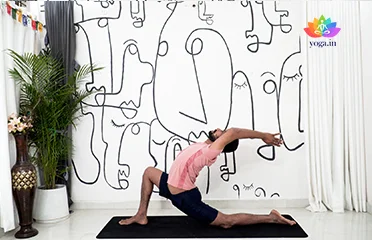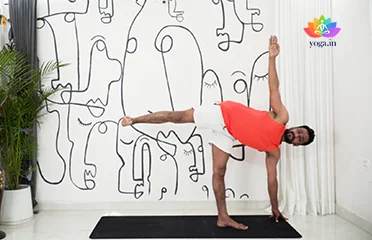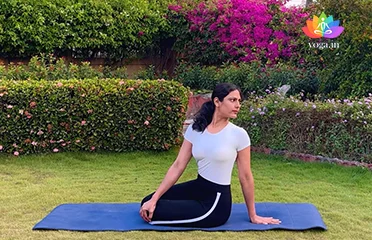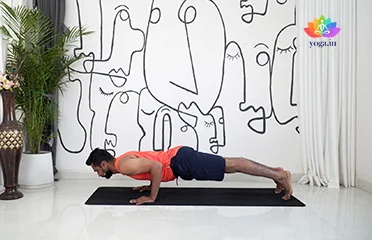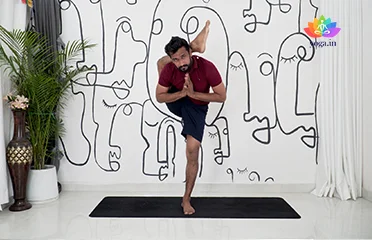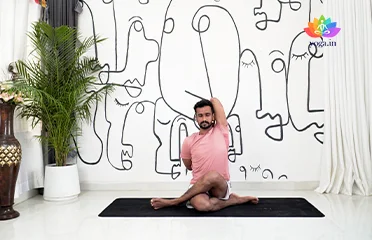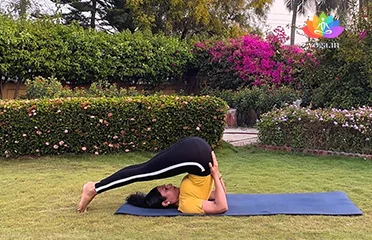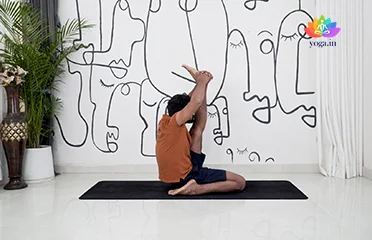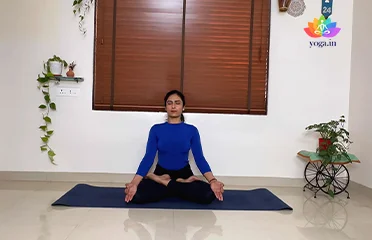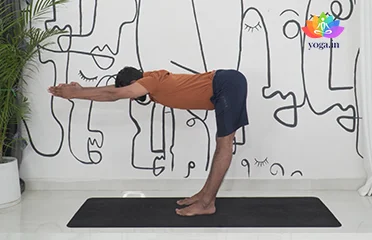Anjaneyasana (Crescent Moon Pose)
आंजनेयासन / Crescent Moon Pose
The Sanskrit name is derived from Anjane (आंजने) meaning Hanuman, [�K]
Ardha Chandrasana (Half Moon Pose)
अर्धचन्द्रासना / Half Moon Pose
The Sanskrit name is derived from Ardha (अर्ध) meaning half, Chandra [�K]
Bharadvajasana (Seated Spinal Twist)
भरद्वाजसन / Seated Spinal Twist
The Sanskrit name is derived from Bhardvaja (भरद्वाज) means bringing [�K]
Chaturanga Dandasana (Low Plank Pose)
चतुरङ्ग दण्डासन / Low Plank Pose
The Sanskrit name is derived from Chatur (चतुर) meaning four, Anga (अङ्ग) [�K]
Durvasasana (Sage Durvasa’s Pose)
दुर्वासासना / Sage Durvasa's Pose
The Sanskrit name is derived from the word Durva (दुर्वा) which [�K]
Gomukhasana (Cow Face Pose)
गोमुखासन / Cow Face Pose
The Sanskrit name is derived from Gau (गो) meaning cow, Mukh meaning face [�K]
Halasana (Plough Pose)
हलासन / Plough Pose
The Sanskrit name is derived from Hala (हला) meaning plough and asana [�K]
Kraunchasana (Heron Pose)
क्रौञ्चासन / Heron Pose
The Sanskrit name is derived from Kraunch (क्रौञ्च) meaning heron [�K]
Padmasana (Lotus Pose)
पद्मासन / Lotus Pose
The Sanskrit name is derived from Padma (पद्मा) meaning lotus and [�K]
Samakonasana (The Right-Angle Posture)
समकोणासन / The Right-Angle Posture
The Sanskrit name is derived from Sama (समा) meaning straight, Kona meaning [�K]
- 1
- 2
How Yoga Can Help Cure Coronary Thrombosis:
Coronary thrombosis occurs when a blood clot forms in one of the coronary arteries, obstructing blood flow to the heart. This can lead to a heart attack or other severe cardiovascular issues. Yoga can play a vital role in managing and preventing coronary thrombosis by reducing stress, improving circulation, and promoting overall cardiovascular health. Through gentle asanas (postures), pranayama (breathing exercises), and meditation, yoga helps maintain a healthy heart and blood vessels.
Understanding Coronary Thrombosis:
Coronary thrombosis is a condition where a blood clot (thrombus) forms in the coronary artery, which supplies blood to the heart muscle. This blockage can restrict or completely stop blood flow, leading to chest pain, heart attacks, and other life-threatening complications. It is a serious medical condition that requires prompt attention and management.
Yoga’s Role in Relieving Coronary Thrombosis:
Specific yoga practices can help alleviate the symptoms and prevent the recurrence of coronary thrombosis. Gentle yoga postures improve blood flow, reduce blood pressure, and enhance cardiovascular function. Pranayama exercises increase oxygen supply to the blood and help in maintaining healthy blood vessels. Meditation reduces stress, which is a significant risk factor for heart diseases.
Key Factors Contributing to Coronary Thrombosis:
- Atherosclerosis: The buildup of fatty deposits (plaques) in the coronary arteries can lead to clot formation.
- High Blood Pressure: Increased pressure can damage arteries, making them more susceptible to thrombosis.
- Smoking: Tobacco use significantly increases the risk of blood clots.
- High Cholesterol: Elevated levels of cholesterol contribute to plaque buildup in the arteries.
- Diabetes: High blood sugar levels can damage blood vessels and increase the risk of clot formation.
- Obesity: Excess weight can lead to atherosclerosis and other cardiovascular problems.
- Sedentary Lifestyle: Lack of physical activity can contribute to poor cardiovascular health.
Symptoms of Coronary Thrombosis:
- Chest Pain: A common symptom, often described as a squeezing or pressure sensation in the chest.
- Shortness of Breath: Difficulty breathing or feeling out of breath, especially during physical activity.
- Sweating: Excessive sweating without any apparent reason.
- Nausea or Vomiting: Feeling nauseated or vomiting, which can accompany other symptoms.
- Fatigue: Unexplained fatigue or weakness, even with minimal exertion.
- Pain in Other Areas: Discomfort or pain radiating to the arms, back, neck, jaw, or stomach.
Treatment of Coronary Thrombosis through Yoga and Pranayama:
Yoga and pranayama can be effective in managing coronary thrombosis by improving cardiovascular health and reducing stress. Some beneficial practices include:
Specific Yoga Poses:
- Tadasana (Mountain Pose): Enhances posture and promotes blood circulation.
- Setu Bandhasana (Bridge Pose): Strengthens the heart muscles and improves blood flow.
- Viparita Karani (Legs-Up-the-Wall Pose): Helps in reducing blood pressure and stress.
Pranayama Exercises:
- Anulom Vilom (Alternate Nostril Breathing): Balances the nervous system and improves heart health.
- Bhramari (Bee Breath): Calms the mind and reduces blood pressure.
- Shavasana (Corpse Pose): Promotes relaxation and reduces stress.
Diet for Coronary Thrombosis:
A heart-healthy diet is crucial for managing coronary thrombosis. Recommendations include:
- Low-Fat Diet: Reduce intake of saturated and trans fats.
- Rich in Fruits and Vegetables: High in antioxidants and fiber.
- Whole Grains: Such as oats, brown rice, and whole wheat.
- Lean Proteins: Such as fish, poultry, and legumes.
- Limit Salt: To manage blood pressure.
- Stay Hydrated: Drink plenty of water.
Caution for Coronary Thrombosis:
When practicing yoga for coronary thrombosis, it is essential to:
- Avoid intense or high-impact yoga poses.
- Listen to your body and avoid any strain or discomfort.
- Consult with a healthcare provider before starting a new yoga routine.
- Practice under the guidance of a qualified yoga instructor.
Contraindications for Coronary Thrombosis:
- Individuals with coronary thrombosis should avoid
- High-intensity yoga practices and poses that strain the heart.
- Inversions and poses that increase blood pressure.
- Yoga practices without medical supervision if there is a history of severe heart issues.


